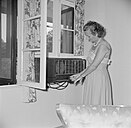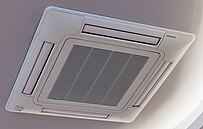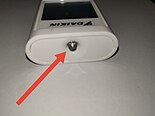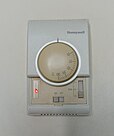
A | B | C | D | E | F | G | H | CH | I | J | K | L | M | N | O | P | Q | R | S | T | U | V | W | X | Y | Z | 0 | 1 | 2 | 3 | 4 | 5 | 6 | 7 | 8 | 9
Air conditioning, often abbreviated as A/C (US) or air con (UK),[1] is the process of removing heat from an enclosed space to achieve a more comfortable interior temperature (sometimes referred to as 'comfort cooling') and in some cases also strictly controlling the humidity of internal air. Air conditioning can be achieved using a mechanical 'air conditioner' or by other methods, including passive cooling and ventilative cooling.[2][3] Air conditioning is a member of a family of systems and techniques that provide heating, ventilation, and air conditioning (HVAC).[4] Heat pumps are similar in many ways to air conditioners, but use a reversing valve to allow them both to heat and to cool an enclosed space.[5]
Air conditioners, which typically use vapor-compression refrigeration, range in size from small units used in vehicles or single rooms to massive units that can cool large buildings.[6] Air source heat pumps, which can be used for heating as well as cooling, are becoming increasingly common in cooler climates.
Air conditioners can reduce mortality rates due to higher temperature.[7] According to the International Energy Agency (IEA) 1.6 billion air conditioning units were used globally in 2016.[8] The United Nations called for the technology to be made more sustainable to mitigate climate change and for the use of alternatives, like passive cooling, evaporative cooling, selective shading, windcatchers, and better thermal insulation.
History
Air conditioning dates back to prehistory.[9] Double-walled living quarters, with a gap between the two walls to encourage air flow, were found in the ancient city of Hamoukar, in modern Syria.[10] Ancient Egyptian buildings also used a wide variety of passive air-conditioning techniques.[11] These became widespread from the Iberian Peninsula through North Africa, the Middle East, and Northern India.[12]
Passive techniques remained widespread until the 20th century when they fell out of fashion and were replaced by powered air conditioning. Using information from engineering studies of traditional buildings, passive techniques are being revived and modified for 21st-century architectural designs.[13][12]

Air conditioners allow the building's indoor environment to remain relatively constant, largely independent of changes in external weather conditions and internal heat loads. They also enable deep plan buildings to be created and have allowed people to live comfortably in hotter parts of the world, but have now come under criticism for contributing significantly to climate-change due to their high electricity consumption and the warming of their immediate surroundings in large cities.[14][15]
Development
Preceding discoveries
In 1558, Giambattista della Porta described a method of chilling ice to temperatures far below its freezing point by mixing it with potassium nitrate (then called "nitre") in his popular science book Natural Magic.[16][17][18] In 1620, Cornelis Drebbel demonstrated "Turning Summer into Winter" for James I of England, chilling part of the Great Hall of Westminster Abbey with an apparatus of troughs and vats.[19] Drebbel's contemporary Francis Bacon, like della Porta a believer in science communication, may not have been present at the demonstration, but in a book published later the same year, he described it as "experiment of artificial freezing" and said that "Nitre (or rather its spirit) is very cold, and hence nitre or salt when added to snow or ice intensifies the cold of the latter, the nitre by adding to its cold, but the salt by supplying activity to the cold of the snow."[16]
In 1758, Benjamin Franklin and John Hadley, a chemistry professor at the University of Cambridge, conducted experiments applying the principle of evaporation as a means to cool an object rapidly. Franklin and Hadley confirmed that the evaporation of highly volatile liquids (such as alcohol and ether) could be used to drive down the temperature of an object past the freezing point of water. They experimented with the bulb of a mercury-in-glass thermometer as their object. They used a bellows to speed up the evaporation. They lowered the temperature of the thermometer bulb down to −14 °C (7 °F) while the ambient temperature was 18 °C (64 °F). Franklin noted that soon after they passed the freezing point of water 0 °C (32 °F), a thin film of ice formed on the surface of the thermometer's bulb and that the ice mass was about 6 mm (1⁄4 in) thick when they stopped the experiment upon reaching −14 °C (7 °F). Franklin concluded: "From this experiment, one may see the possibility of freezing a man to death on a warm summer's day."[20]
The 19th century included many developments in compression technology. In 1820, English scientist and inventor Michael Faraday discovered that compressing and liquefying ammonia could chill air when the liquefied ammonia was allowed to evaporate.[21] In 1842, Florida physician John Gorrie used compressor technology to create ice, which he used to cool air for his patients in his hospital in Apalachicola, Florida. He hoped to eventually use his ice-making machine to regulate the temperature of buildings.[21][22] He envisioned centralized air conditioning that could cool entire cities. Gorrie was granted a patent in 1851, but following the death of his main backer, he was not able to realize his invention.[23] In 1851, James Harrison created the first mechanical ice-making machine in Geelong, Australia, and was granted a patent for an ether vapor-compression refrigeration system in 1855 that produced three tons of ice per day.[24] In 1860, Harrison established a second ice company. He later entered the debate over competing against the American advantage of ice-refrigerated beef sales to the United Kingdom.[24]
First devices
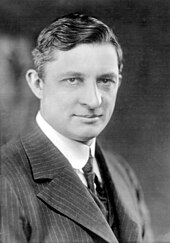
Electricity made the development of effective units possible. In 1901, American inventor Willis H. Carrier built what is considered the first modern electrical air conditioning unit.[25][26][27][28] In 1902, he installed his first air-conditioning system, in the Sackett-Wilhelms Lithographing & Publishing Company in Brooklyn, New York.[29] His invention controlled both the temperature and humidity, which helped maintain consistent paper dimensions and ink alignment at the printing plant. Later, together with six other employees, Carrier formed The Carrier Air Conditioning Company of America, a business that in 2020 employed 53,000 people and was valued at $18.6 billion.[30][31]
In 1906, Stuart W. Cramer of Charlotte, North Carolina, was exploring ways to add moisture to the air in his textile mill. Cramer coined the term "air conditioning", by it in a patent claim he filed that year as analogous to "water conditioning", then a well-known process for making textiles easier to process. He combined moisture with ventilation to "condition" and change the air in the factories; thus, controlling the humidity that is necessary in textile plants. Willis Carrier adopted the term and incorporated it into the name of his company.[32]
Domestic air conditioning soon took off. In 1914, the first domestic air conditioning was installed in Minneapolis in the home of Charles Gilbert Gates. It is, however, possible that the considerable device (c. 2.1 m × 1.8 m × 6.1 m; 7 ft × 6 ft × 20 ft) was never used, as the house remained uninhabited[21](Gates had already died in October 1913).
In 1931, H.H. Schultz and J.Q. Sherman developed what would become the most common type of individual room air conditioner: one designed to sit on a window ledge. The units went on sale in 1932 at US$10,000 to $50,000 (the equivalent of $200,000 to $1,100,000 in 2023.)[21] A year later, the first air conditioning systems for cars were offered for sale.[33] Chrysler Motors introduced the first practical semi-portable air conditioning unit in 1935,[34] and Packard became the first automobile manufacturer to offer an air conditioning unit in its cars in 1939.[35]
Further development
Innovations in the latter half of the 20th century allowed more ubiquitous air conditioner use. In 1945, Robert Sherman of Lynn, Massachusetts, invented a portable, in-window air conditioner that cooled, heated, humidified, dehumidified, and filtered the air.[36] The first inverter air conditioners were released in 1980–1981.[37][38]
Air conditioner adoption tends to increase above around $10,000 annual household income in warmer areas.[39] Global GDP growth explains around 85% of increased air condition adoption by 2050, while the remaining 15% can be explained by climate change.[39]
As of 2016 an estimated 1.6 billion air conditioning units were used worldwide, with over half of them in China and USA, and a total cooling capacity of 11675 gigawatts.[8][40] The International Energy Agency predicted in 2018 that the number of air conditioning units will grow to around 4 billion units by 2050 and the total cooling capacity will grow to around 23000 GW, with the biggest increases in India and China.[8] Between 1995 and 2004, the proportion of urban households in China with air conditioners increased from 8% to 70%.[41] As of 2015, nearly 100 million homes, or about 87% of US households, had air conditioning systems.[42] In 2019, it was estimated that 90% of new single-family homes constructed in the US included air conditioning (ranging from 99% in the South to 62% in the West).[43][44]
Operation
Operating principles

Cooling in traditional air conditioner systems is accomplished using the vapor-compression cycle, which uses a refrigerant's forced circulation and phase change between gas and liquid to transfer heat.[45][46] The vapor-compression cycle can occur within a unitary, or packaged piece of equipment; or within a chiller that is connected to terminal cooling equipment (such as a fan coil unit in an air handler) on its evaporator side and heat rejection equipment such as a cooling tower on its condenser side. An air source heat pump shares many components with an air conditioning system, but includes a reversing valve, which allows the unit to be used to heat as well as cool a space.[47]
Air conditioning equipment will reduce the absolute humidity of the air processed by the system if the surface of the evaporator coil is significantly cooler than the dew point of the surrounding air. An air conditioner designed for an occupied space will typically achieve a 30% to 60% relative humidity in the occupied space.[48]
Most modern air-conditioning systems feature a dehumidification cycle during which the compressor runs. At the same time, the fan is slowed to reduce the evaporator temperature and condense more water. A dehumidifier uses the same refrigeration cycle but incorporates both the evaporator and the condenser into the same air path; the air first passes over the evaporator coil, where it is cooled[49] and dehumidified before passes over the condenser coil, where it is warmed again before being released back into the room again.[citation needed]
Free cooling can sometimes be selected when the external air is cooler than the internal air. Therefore, the compressor does not need to be used, resulting in high cooling efficiencies for these times. This may also be combined with seasonal thermal energy storage.[50]
Heating
Some air conditioning systems can reverse the refrigeration cycle and act as an air source heat pump, thus heating instead of cooling the indoor environment. They are also commonly referred to as "reverse cycle air conditioners". The heat pump is significantly more energy-efficient than electric resistance heating, because it moves energy from air or groundwater to the heated space and the heat from purchased electrical energy. When the heat pump is in heating mode, the indoor evaporator coil switches roles and becomes the condenser coil, producing heat. The outdoor condenser unit also switches roles to serve as the evaporator and discharges cold air (colder than the ambient outdoor air).
Most air source heat pumps become less efficient in outdoor temperatures lower than 4 °C or 40 °F.[51] This is partly because ice forms on the outdoor unit's heat exchanger coil, which blocks air flow over the coil. To compensate for this, the heat pump system must temporarily switch back into the regular air conditioning mode to switch the outdoor evaporator coil back to the condenser coil, to heat up and defrost. Therefore, some heat pump systems will have electric resistance heating in the indoor air path that is activated only in this mode to compensate for the temporary indoor air cooling, which would otherwise be uncomfortable in the winter.
Newer models have improved cold-weather performance, with efficient heating capacity down to −14 °F (−26 °C).[52][51][53] However, there is always a chance that the humidity that condenses on the heat exchanger of the outdoor unit could freeze, even in models that have improved cold-weather performance, requiring a defrosting cycle to be performed.
The icing problem becomes much more severe with lower outdoor temperatures, so heat pumps are sometimes installed in tandem with a more conventional form of heating, such as an electrical heater, a natural gas, heating oil, or wood-burning fireplace or central heating, which is used instead of or in addition to the heat pump during harsher winter temperatures. In this case, the heat pump is used efficiently during milder temperatures, and the system is switched to the conventional heat source when the outdoor temperature is lower.
Performance
The coefficient of performance (COP) of an air conditioning system is a ratio of useful heating or cooling provided to the work required.[54][55] Higher COPs equate to lower operating costs. The COP usually exceeds 1; however, the exact value is highly dependent on operating conditions, especially absolute temperature and relative temperature between sink and system, and is often graphed or averaged against expected conditions.[56] Air conditioner equipment power in the U.S. is often described in terms of "tons of refrigeration", with each approximately equal to the cooling power of one short ton (2,000 pounds (910 kg) of ice melting in a 24-hour period. The value is equal to 12,000 BTUIT per hour, or 3,517 watts.[57] Residential central air systems are usually from 1 to 5 tons (3.5 to 18 kW) in capacity.[citation needed]
The efficiency of air conditioners is often rated by the seasonal energy efficiency ratio (SEER), which is defined by the Air Conditioning, Heating and Refrigeration Institute in its 2008 standard AHRI 210/240, Performance Rating of Unitary Air-Conditioning and Air-Source Heat Pump Equipment.[58] A similar standard is the European seasonal energy efficiency ratio (ESEER).[citation needed]
Control system
Wireless remote control
This type of controller uses an infrared LED to relay commands from a remote control to the air conditioner. The output of the infrared LED (like that of any infrared remote) is invisible to the human eye because its wavelength is beyond the range of visible light (940 nm). This controller is commonly used on mini-split air conditioners because it is simple and portable. Some window and ducted central air conditioners uses it as well.
Wired controller
A wired controller, also called a "wired thermostat," is a device that controls an air conditioner by switching heating or cooling on or off. It uses different sensors to measure temperatures and actuate control operations. Mechanical thermostats commonly use bimetallic strips, converting a temperature change into mechanical displacement, to actuate control of the air conditioner. Electronic thermostats, instead, use a thermistor or other semiconductor sensor, processing temperature change as electronic signals to control the air conditioner.
These controllers are usually used in hotel rooms because they are permanently installed into a wall and hard-wired directly into the air conditioner unit, eliminating the need for batteries.
Types
| Types | Typical Capacity* | Air supply | Mounting | Typical application |
|---|---|---|---|---|
| Mini-split | small – large | Direct | Wall | Residential |
| Window | very small – small | Direct | Window | Residential |
| Portable | very small – small | Direct / Ducted | Floor | Residential, remote areas |
| Ducted (individual) | small – very large | Ducted | Ceiling | Residential, commercial |
| Ducted (central) | medium – very large | Ducted | Ceiling | Residential, commercial |
| Ceiling suspended | medium – large | Direct | Ceiling | Commercial |
| Cassette | medium – large | Direct / Ducted | Ceiling | Commercial |
| Floor standing | medium – large | Direct / Ducted | Floor | Commercial |
| Packaged | very large | Direct / Ducted | Floor | Commercial |
| Packaged RTU (Rooftop Unit) | very large | Ducted | Rooftop | Commercial |
* where the typical capacity is in kilowatt as follows:
- very small: <1.5 kW
- small: 1.5–3.5 kW
- medium: 4.2–7.1 kW
- large: 7.2–14 kW
- very large: >14 kW
Mini-split and multi-split systems
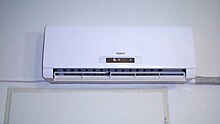
Ductless systems (often mini-split, though there are now ducted mini-split) typically supply conditioned and heated air to a single or a few rooms of a building, without ducts and in a decentralized manner.[59] Multi-zone or multi-split systems are a common application of ductless systems and allow up to eight rooms (zones or locations) to be conditioned independently from each other, each with its indoor unit and simultaneously from a single outdoor unit.
The first mini-split system was sold in 1961 by Toshiba in Japan, and the first wall-mounted mini-split air conditioner was sold in 1968 in Japan by Mitsubishi Electric, where small home sizes motivated their development. The Mitsubishi model was the first air conditioner with a cross-flow fan.[60][61][62] In 1969, the first mini-split air conditioner was sold in the US.[63] Multi-zone ductless systems were invented by Daikin in 1973, and variable refrigerant flow systems (which can be thought of as larger multi-split systems) were also invented by Daikin in 1982. Both were first sold in Japan.[64] Variable refrigerant flow systems when compared with central plant cooling from an air handler, eliminate the need for large cool air ducts, air handlers, and chillers; instead cool refrigerant is transported through much smaller pipes to the indoor units in the spaces to be conditioned, thus allowing for less space above dropped ceilings and a lower structural impact, while also allowing for more individual and independent temperature control of spaces. The outdoor and indoor units can be spread across the building.[65] Variable refrigerant flow indoor units can also be turned off individually in unused spaces.[citation needed] The lower start-up power of VRF's DC inverter compressors and their inherent DC power requirements also allow VRF solar-powered heat pumps to be run using DC-providing solar panels.
Ducted central systems
Split-system central air conditioners consist of two heat exchangers, an outside unit (the condenser) from which heat is rejected to the environment and an internal heat exchanger (the evaporator, or Fan Coil Unit, FCU) with the piped refrigerant being circulated between the two. The FCU is then connected to the spaces to be cooled by ventilation ducts.[66]
Central plant cooling

Large central cooling plants may use intermediate coolant such as chilled water pumped into air handlers or fan coil units near or in the spaces to be cooled which then duct or deliver cold air into the spaces to be conditioned, rather than ducting cold air directly to these spaces from the plant, which is not done due to the low density and heat capacity of air, which would require impractically large ducts. The chilled water is cooled by chillers in the plant, which uses a refrigeration cycle to cool water, often transferring its heat to the atmosphere even in liquid-cooled chillers through the use of cooling towers. Chillers may be air- or liquid-cooled.[citation needed]
Portable units
A portable system has an indoor unit on wheels connected to an outdoor unit via flexible pipes, similar to a permanently fixed installed unit (such as a ductless split air conditioner).
Hose systems, which can be monoblock or air-to-air, are vented to the outside via air ducts. The monoblock type collects the water in a bucket or tray and stops when full. The air-to-air type re-evaporates the water, discharges it through the ducted hose, and can run continuously. Such portable units draw indoor air and expel it outdoors through a single duct, negatively impacting their overall cooling efficiency.
Many portable air conditioners come with heat as well as a dehumidification function.[67]
Window unit and packaged terminal
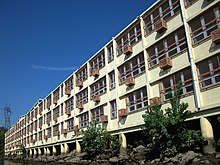
The packaged terminal air conditioner (PTAC), through-the-wall, and window air conditioners are similar. These units are installed on a window frame or on a wall opening. The unit usually has an internal partition separating its indoor and outdoor sides, which contain the unit's condenser and evaporator, respectively. PTAC systems may be adapted to provide heating in cold weather, either directly by using an electric strip, gas, or other heaters, or by reversing the refrigerant flow to heat the interior and draw heat from the exterior air, converting the air conditioner into a heat pump. They may be installed in a wall opening with the help of a special sleeve on the wall and a custom grill that is flush with the wall and window air conditioners can also be installed in a window, but without a custom grill.[68]
Packaged air conditioner
Packaged air conditioners (also known as self-contained units)[69][70] are central systems that integrate into a single housing all the components of a split central system, and deliver air, possibly through ducts, to the spaces to be cooled. Depending on their construction they may be outdoors or indoors, on roofs (rooftop units),[71][72] draw the air to be conditioned from inside or outside a building and be water or air-cooled. Often, outdoor units are air-cooled while indoor units are liquid-cooled using a cooling tower.[66][73][74][75][76][77]
Types of compressors
| Compressor types | Common applications | Typical capacity | Efficiency | Durability | Repairability |
|---|---|---|---|---|---|
| Reciprocating | Refrigerator, Walk-in freezer, portable air conditioners | small – large | very low (small capacity)
medium (large capacity) |
very low | medium |
| Rotary vane | Residential mini splits | small | low | low | easy |
| Scroll | Commercial and central systems, VRF | medium | medium | medium | easy |
| Rotary screw | Commercial chiller | medium – large | medium | medium | hard
Zdroj:https://en.wikipedia.org?pojem=Air_conditioned Text je dostupný za podmienok Creative Commons Attribution/Share-Alike License 3.0 Unported; prípadne za ďalších podmienok. Podrobnejšie informácie nájdete na stránke Podmienky použitia.
Analytika
Antropológia Aplikované vedy Bibliometria Dejiny vedy Encyklopédie Filozofia vedy Forenzné vedy Humanitné vedy Knižničná veda Kryogenika Kryptológia Kulturológia Literárna veda Medzidisciplinárne oblasti Metódy kvantitatívnej analýzy Metavedy Metodika Text je dostupný za podmienok Creative
Commons Attribution/Share-Alike License 3.0 Unported; prípadne za ďalších
podmienok. www.astronomia.sk | www.biologia.sk | www.botanika.sk | www.dejiny.sk | www.economy.sk | www.elektrotechnika.sk | www.estetika.sk | www.farmakologia.sk | www.filozofia.sk | Fyzika | www.futurologia.sk | www.genetika.sk | www.chemia.sk | www.lingvistika.sk | www.politologia.sk | www.psychologia.sk | www.sexuologia.sk | www.sociologia.sk | www.veda.sk I www.zoologia.sk |

